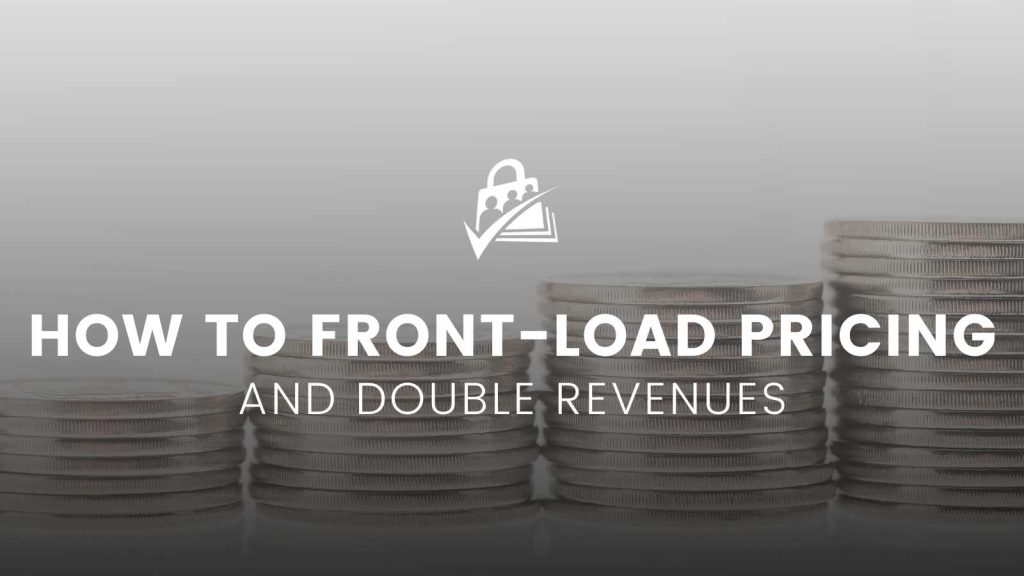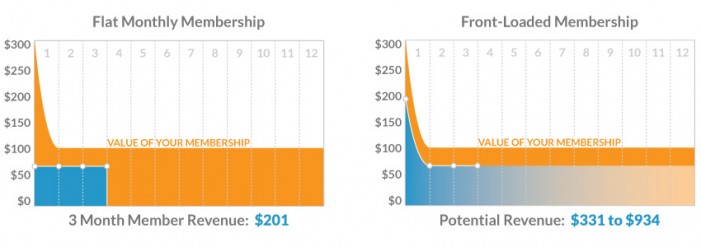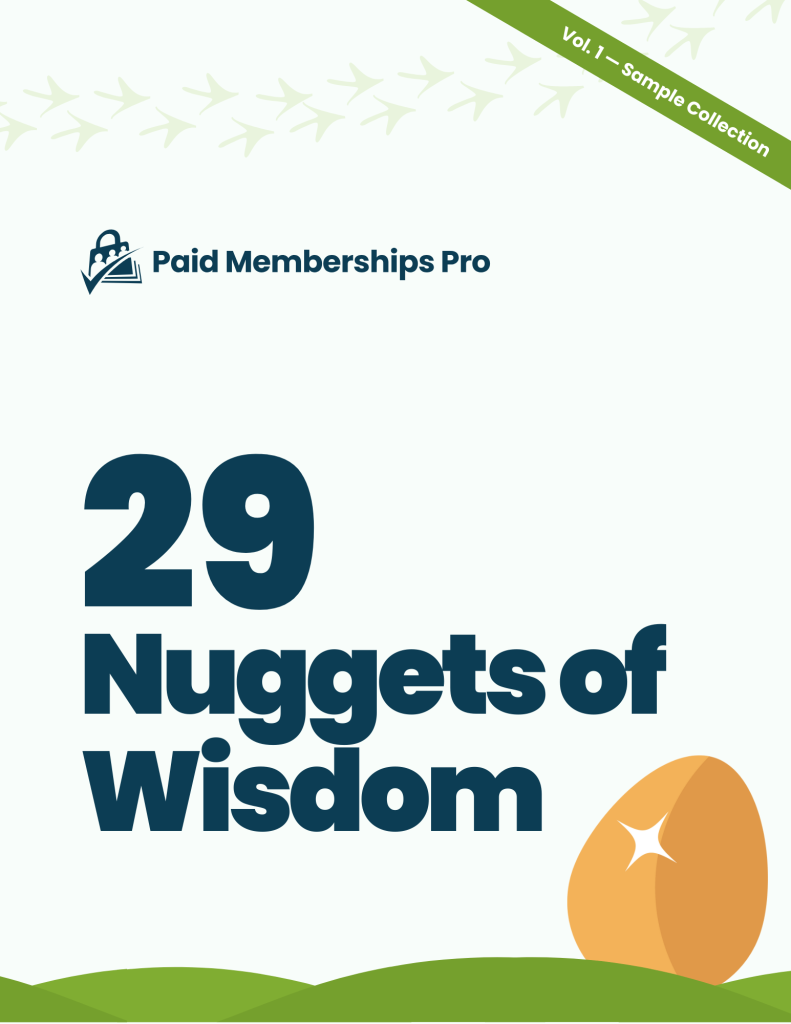Link bait title, I know, but this one change in your pricing could improve your revenues drastically. I see a large number of membership sites all making this same mistake over and over. I wanted to put this information out there to help you out.
Put simply, your membership pricing should match the value your membership provides, both in terms of (1) price and (2) timing.
Let’s break that down.

Table of contents
- 1. The price of your membership level should match the value your membership provides.
- 2. The timing of your membership pricing should match the timing of the value you provide.
- What should you do?
- Case Study 1: Paid Memberships Pro
- Case Study 2: James Swanwick’s 30 Day Alcohol Free Challenge
- On Doubling Revenues
- In Summary…
1. The price of your membership level should match the value your membership provides.
Most people understand #1, so I won’t explore this too much. There is a lot of advice out there that boils down to “increase your prices”, which is generally a good idea. Launching a membership site takes enough hubris by itself; you’re telling the world that you know something they should pay money for. Many site owners will set their prices too low, caving into fears that “nobody will buy my membership”. Don’t be afraid to set your price higher, even after you’ve launched. Just grandfather your existing members into the old plan and focus on obtaining new customers at the higher price.
2. The timing of your membership pricing should match the timing of the value you provide.
This is the mistake that I keep seeing people make. Most membership products deliver an incredible amount of value up front and then some residual value over time after that.
Lured by the appeal of passive income, MRR (Monthly Recurring Revenue), or generally more consistent revenue, entrepreneurs will give their membership a price like $67 per month, and then work to provide content and value to justify that monthly cost.
But even if you are giving your members more than $67 of value every month, it’s not going to be enough. When you charge the same price every month, you have to provide the same amount of value you provided in month one or your members are going to notice that they are getting less value but paying the same price.
You can’t expect your members to understand what a great deal they are getting paying $67 for $100 in value. They will just feel and know that they aren’t getting $200 in value anymore. They will still feel underserved, or worse cheated, and they will cancel.
What should you do?
The answer is pretty simple: Charge a higher price up front, and then a lower monthly or annual price.
The great part about this is that you can usually make this change without impacting your sales. Any pricing change should be done with care and (if possible) tested first. If you do this right you should see a nice increase in monthly revenue and monthly retention, with only a slight decrease in initial sales.
This chart compares a flat monthly membership fee to a front-loaded membership with ongoing monthly price. The chart assumes that the member cancels after month 3. However, in the front-loaded setup we would expect churn rates to go down, with more people keeping their memberships into month 4, 5, 6, and on.
Here are some examples to help to understand this.
Case Study 1: Paid Memberships Pro
We struggled through this pricing dilemma ourselves way back in 2012. When we first launched the site, our membership was $19 per month. Many folks liked this price, and we had a good number of members happy to pay that price every month for access to our support, documentation, and good will. However, most members were canceling their membership within 6 months. The average member stuck around for 3 months, paying us $57.
Some would sign up, get their support, and then almost cancel immediately… and then do that again a couple months later when they had another question. They were effectively paying $19 per support question instead of $19 per month.
We tried to deliver great content every month by releasing new addons and business focused blog posts. But nothing we released could live up to the value delivered that first month.
This wasn’t sustainable, and we realized that the high amount of churn wasn’t because our members were to dumb to understand the value of our membership. We needed to make sure that timing of our pricing matched the timing of the value we provided.
So instead of $19 per month, we started charging $97 up front and $47 per year to renew.
We went from 45 sales in May 2012 to 13 sales in June. But because we were charging $97 instead of $19 our total revenue went up. With a more sustainable price and the focus to deliver value up front, we could drive sales harder. We also benefitted by having fewer cancellations and charge backs to deal with.
Case Study 2: James Swanwick’s 30 Day Alcohol Free Challenge
This is a hypothetical case study based on what I heard of James’ membership site on episode 119 of Nathan Latka’s The Top Podcast. I don’t know James and haven’t spoken to him. So this is just some free advice.
On the podcast James says he is charging $67 per month. For $67, you get access to the 30 Day Alcohol Free Challenege and also a private Facebook group for members. During the first month, members get an automated email every day that helps them get through the first month alcohol free… a process that could help you lose 10 pounds, save hundreds of dollars a month, give you more energy for business, and change your entire life. The second month, you get access to the Facebook group.
Nathan has asked many guests on his show how they can continue to deliver value every month to their members. Most guests don’t have a good answer.
In James’ case, I would bet that access to the Facebook group is worth more than $67 per month. Let’s put it at $100/month. However, that $100/month pales in comparison to the life altering value delivered in month one. Just the savings on your alcohol budget alone is worth hundreds of dollars per month. Losing 10 pounds is worth $100 a pound. The value is off the charts and no matter what James does, he’s not going to be able to deliver for his members in month 2 like he did in month one.
If I were running the 30 Day Alcohol Free Challenge, I would charge $200 up front and $67 per month.
Raising the price by 3x will lower the number of sign ups. But it probably won’t cut sign ups by 1/3. If James was getting 100 people to sign up for $67 ($6,700), I’m guessing he could get 50 people to sign up for $200 ($10,000). That’s 50% fewer sales but almost 50% more revenue!
With the value James’ product is delivering, I’m not even sure sales would drop 50%. When we released the PMPro Plus level and effectively doubled the price of a membership here, we saw sales go up not down.
I would consider lowering the monthly fee, but I think he could keep it at $67. Even though members will be getting the same Facebook group for the same price, their perception will be different. Instead of comparing the $67 to the value from the first month, members will be grateful for the “price drop” and should be more inclined to stick around. With a pricing structure that matches the timing of value, James should see lower churn and higher lifetime value from his members.
On Doubling Revenues
There are a lot of different factors that will affect what exactly happens after making a pricing change like this, but just to address my strongly worded title, here is the math on how making this change could result in doubled revenue.
Starting with the numbers from our second case study. Let’s assume we have 100 people per month paying $67 for an average of 3 months. That’s $67 x 3 x 100 = $20,100. (FWIW, James said he was getting $14/mo, but we’re also guessing his incoming members number. Let’s just run with these numbers.)
If we switch to $200 the first month, then $67 per month, we end up with ($200 + $67 * 2) * 100 = $33,400.
If we assume that the new pricing leads to more folks staying into months 4 and 5, we could get ($200 + $67 * 4) = $46,800 in revenue.
I pulled most of these numbers out of my butt, but they are based on our experience with our site here and some reasonable assumptions on customer psychology. Your milage may vary.
In Summary…
Your membership pricing should match the value your membership provides, both in terms of price and timing.
To do that consider charging a high price up front and then a lower monthly or annual recurring price.
Not every site will be able to take advantage of this setup. If you’re selling access to a monthly new blog, or would rather optimize for number of customers vs overall revenue, it won’t make sense to increase your up front price. This setup works best for memberships that dump a ton of content and value at the time of checkout.


